Enermax Revolution 85+ High Efficiency PSU
by Christoph Katzer on November 6, 2008 4:15 AM EST- Posted in
- Cases/Cooling/PSUs
DC Output Stability and Quality
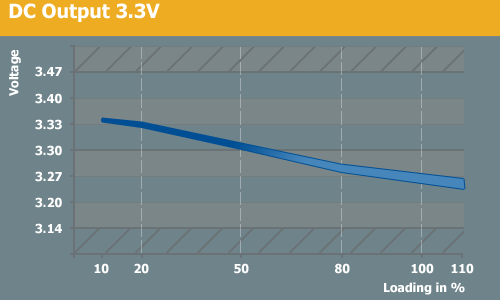
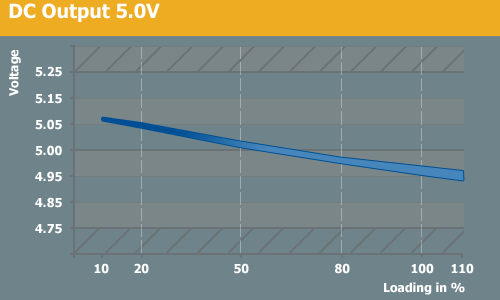
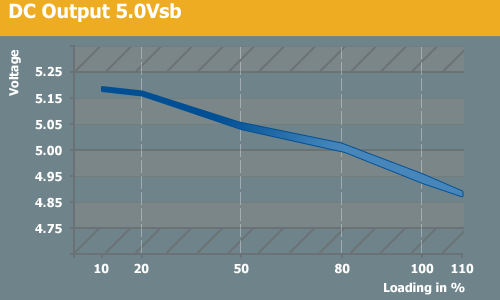
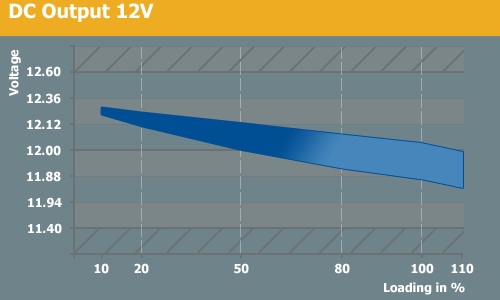
The DC output regulation is excellent with this power supply. Both the 3.3V and 5V rails have a regulation little over 2%; even at maximum loads of over 1000W, they stay just 1% under the ideal output. The standby rail has a larger regulation of around 6%, which is still within specs and seldom a cause for concern. As always, we combined all 12V rails into one graph. This time it represents six 12V rails, which is why the graph is so thick. With six rails, the various outputs will never be identical, and we measured a difference of roughly 0.15V at higher loads. Despite the spread between the 12V rails, we still get a voltage regulation of around 3%, which is a very good result.

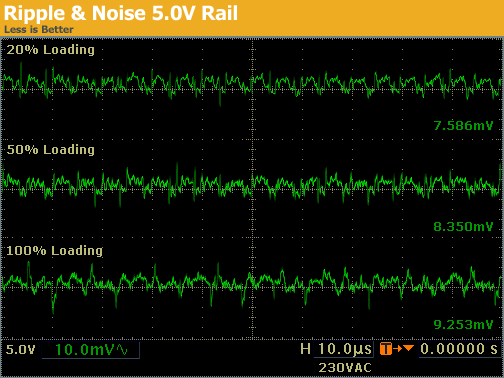
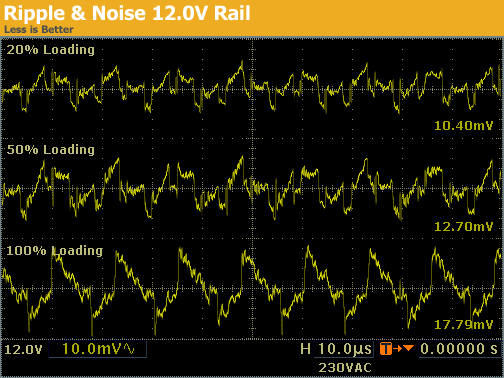
The 3.3V and 5V output quality is okay, and the 3.3V rail is the worst we'll see from this PSU with a ripple result of 14.6mV. 12V1 has the lowest ripple with up to 17.79mV while the other 12V rails reach up to 30mV, but the overall results are similar to 12V1.










49 Comments
View All Comments
takumsawsherman - Thursday, November 6, 2008 - link
Forgive me for my ignorance, but isn't it the 5V rail that takes care of hard drive power? The reason I ask is that I have a Enermax Whisper 350 that is about 5 years old, and it has 32A on the 5V rail. I can use 4 Hard drives max before the power supply starts to have issues.Does this mean that this power supply could only handle 3? My 3.3 rail is also 30A, and this unit seems to only provide 25. Why so little?
Again, I am looking to be educated, I'm not yet criticizing because I realize that my assumptions are probably incorrect. I've been window shopping for Hard drives for a while now (750GB is not enough any more) and I know i can't add more to my current setup unless I get a better power supply.
Trippytiger - Friday, November 7, 2008 - link
I believe 3.5" hard drives receive power on both the +5V and +12V rails. That the power supplies for external hard drive enclosures provide both voltages suggests this.I'm guessing, given how old your PSU is and how much juice it has on the +5V and +3.3V rails, that its +12V rail is on the weak side and that's the reason it has issues with large numbers of hard drives. It sounds like it was designed to ATX 1.3 specs and was intended for system with a CPU running off of the 5V rail. Since all modern (and not so modern) processors take power from the +12V rail these days, the +5V rail just isn't as critical as it used to be.
You'd probably be much better off with a newer PSU with more power on the +12V rail. Of course, if your system does happen to be ancient... good luck finding something suitable. I went shopping for a PSU for my old AXP+ system several years ago and had a hell of a time finding a unit with a beefy +5V rail back then!
xaris106 - Thursday, November 6, 2008 - link
I`m not sure i understand that "syncronized transformers". But if they work in parallel I am a bit concerned for the approach as variations in the resistance, impendance and coupling factors between the two can lead to unbalanced loading. And it could get worse as components burn in and age.As for the kill a watt measurements I would like to point out that the number is not what the pc components need in power. It includes the psu loses. that means a 300W kill-a-watt measurement means the parts draw 240W (and the psu load) with a 80% efficient psu
JonnyDough - Thursday, November 6, 2008 - link
Try learning words like "kilowatt" and "losses" and then post.xaris106 - Thursday, November 6, 2008 - link
yeah I see why you said that... with "kill-a-watt" i was referring to the wattmeter device that people use in their electric outlets to measure power consumption. I wasn't referring to killowatts...I also misspelled "losses". again sorry for my english.The0ne - Friday, November 7, 2008 - link
You don't need to apologize for your grammar or misspellings on here. People need to understand that there are other members of different race and from different countries to not STUPIDLY assume that they are the only one that matters in the world. If the person is going to make such stupid comments lets see him/her try it on a non-english topic and then report back. Chances are, he/she is probably to lazy in the first place to pick up a second language to even consider trying.That aside, it's the web. Even I don't care about my grammar or spelling here and I write technical reports on a daily basis where I work (to a certain extent of course hahah).
JarredWalton - Friday, November 7, 2008 - link
The power loads in our PSU reviews are *not* measured using a Kill-A-Watt or similar device; see the page on the Chroma testing equipment. When we say there's a 500W load on a PSU and that PSU is 89% efficient at that load, it means the PSU is drawing 562W at the outlet. Our other articles use wall power (because we don't have the equipment elsewhere to measure actual loads).xaris106 - Friday, November 7, 2008 - link
Yes, I know you didn't use a simple wattmeter. Your equipment and test is impressive I would say. I was referring to a comment in page 1 that mentioned a kill-a-watt.As a suggestion, in reviews that you do use outlet power, it would be nice to make a note of it and that the numbers include power losses (and even the approximate efficiency if you use a tested psu) so people can have it in mind.
Now just an idea.Wouldn't it be nice for you to make a set of connectors that plug between the psu connectors and the motherboard/devices that can go through ampmeters? So we can see all those dc currents. Although that might me a lot of ampmeters...and a bit risky. Just a thought.
My regards.
The0ne - Friday, November 7, 2008 - link
I don't see why you can't hook up a current probe connected to a O-scope to measure the current.JarredWalton - Friday, November 7, 2008 - link
Christoph did something like that in his http://www.anandtech.com/casecoolingpsus/showdoc.a...">Power Supply Myths article... not really something to do in every review if we can avoid; they take long enough already! ;)